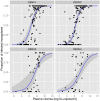Human to mosquito transmission of dengue viruses
- PMID: 24987394
- PMCID: PMC4060056
- DOI: 10.3389/fimmu.2014.00290
Human to mosquito transmission of dengue viruses
Abstract
The successful transmission of dengue virus from a human host to a mosquito vector requires a complex set of factors to align. It is becoming increasingly important to improve our understanding of the parameters that shape the human to mosquito component of the transmission cycle so that vaccines and therapeutic antivirals can be fully evaluated and epidemiological models refined. Here we describe these factors, and discuss the biological and environmental impacts and demographic changes that are influencing these dynamics. Specifically, we examine features of the human infection required for the mosquito to acquire the virus via natural blood feeding, as well as the biological and environmental factors that influence a mosquito's susceptibility to infection, up to the point that they are capable of transmitting the virus to a new host.
Keywords: Aedes aegypti; Aedes albopictus; dengue virus; symptomatic vs. asymptomatic infections; temperature; transmission; viral titer.
Figures


Similar articles
-
Reciprocal tripartite interactions between the Aedes aegypti midgut microbiota, innate immune system and dengue virus influences vector competence.PLoS Negl Trop Dis. 2012;6(3):e1561. doi: 10.1371/journal.pntd.0001561. Epub 2012 Mar 6. PLoS Negl Trop Dis. 2012. PMID: 22413032 Free PMC article.
-
Aedes (Stegomyia) aegypti in the continental United States: a vector at the cool margin of its geographic range.J Med Entomol. 2013 May;50(3):467-78. doi: 10.1603/me12245. J Med Entomol. 2013. PMID: 23802440
-
The impact of temperature and Wolbachia infection on vector competence of potential dengue vectors Aedes aegypti and Aedes albopictus in the transmission of dengue virus serotype 1 in southern Taiwan.Parasit Vectors. 2017 Nov 7;10(1):551. doi: 10.1186/s13071-017-2493-x. Parasit Vectors. 2017. PMID: 29116011 Free PMC article.
-
Natural vertical transmission of dengue virus in Aedes aegypti and Aedes albopictus: a systematic review.Parasit Vectors. 2018 Feb 1;11(1):77. doi: 10.1186/s13071-018-2643-9. Parasit Vectors. 2018. PMID: 29391071 Free PMC article. Review.
-
Molecular pathogenesis of dengue virus infection in Aedes mosquitoes.J Insect Physiol. 2022 Apr;138:104367. doi: 10.1016/j.jinsphys.2022.104367. Epub 2022 Feb 4. J Insect Physiol. 2022. PMID: 35131236 Review.
Cited by
-
Spondweni virus causes fetal harm in Ifnar1-/- mice and is transmitted by Aedes aegypti mosquitoes.Virology. 2020 Aug;547:35-46. doi: 10.1016/j.virol.2020.05.005. Epub 2020 May 24. Virology. 2020. PMID: 32560903 Free PMC article.
-
Dengue outbreak in the times of COVID-19 pandemic: Common myths associated with the dengue.Ann Med Surg (Lond). 2022 Sep;81:104535. doi: 10.1016/j.amsu.2022.104535. Epub 2022 Sep 1. Ann Med Surg (Lond). 2022. PMID: 36065431 Free PMC article.
-
The effect of repeat feeding on dengue virus transmission potential in Wolbachia-infected Aedes aegypti following extended egg quiescence.PLoS Negl Trop Dis. 2024 Jul 8;18(7):e0012305. doi: 10.1371/journal.pntd.0012305. eCollection 2024 Jul. PLoS Negl Trop Dis. 2024. PMID: 38976758 Free PMC article.
-
Multiplexed kit based on Luminex technology and achievements in synthetic biology discriminates Zika, chikungunya, and dengue viruses in mosquitoes.BMC Infect Dis. 2019 May 14;19(1):418. doi: 10.1186/s12879-019-3998-z. BMC Infect Dis. 2019. PMID: 31088375 Free PMC article.
-
Mathematical model estimation of dengue fever transmission risk from Southeast and South Asia into Japan between 2016 and 2018.Environ Health Prev Med. 2023;28:50. doi: 10.1265/ehpm.22-00267. Environ Health Prev Med. 2023. PMID: 37690835 Free PMC article.
References
Publication types
LinkOut - more resources
Full Text Sources
Other Literature Sources

